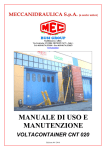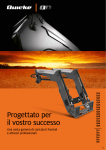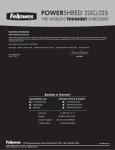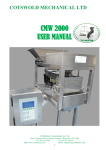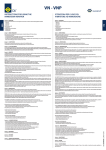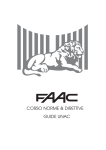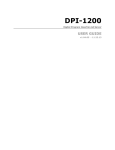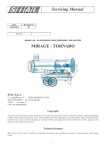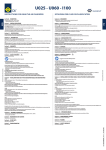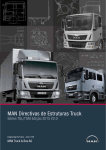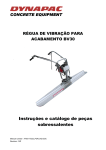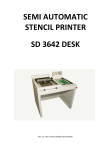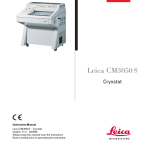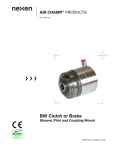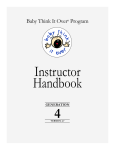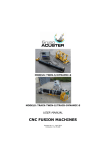Download File
Transcript
USE AND MAINTENANCE MANUAL BOOMS SKIPLOADER MB 16 INDEX PREFACE LIABILITY DECLARATION PART I - BOOMS SKIPLOADER USE SAFETY STANDARDS SAFETY DEVICES AND PROTECTIONS EMERGENCY DEVICE IDENTIFICATION MAIN COMPONENTS TECHNICAL DATA INSTRUCTIONS FOR USE PNEUMATIC SYSTEM OLEODYNAMIC SYSTEM ELECTRICAL UNIT PART II - BOOMS SKIPLOADER MAINTENANCE MAINTENANCE INSTRUCTIONS FUNCTIONING ANOMALIES MAINTENANCE PROGRAM 3 PREFACE This manual contains MECCANIDRAULICA S.p.A. booms skiploader use and maintenance instructions, as well as basic safety standards. CAREFULLY READ THIS MANUAL before starting any operation related to the equipment in order to avoid material damages to the new machine made of lorry with cab, booms skiploader, and skips being used, risking the safety of the operator or of other people or animals, as well as useless waste of time during the installation and use of the booms skiploader. Installation must be performed by MECCANIDRAULICA S.p.A. authorised workshops following instructions in this manual In the event of assemblies assigned to workshops without sufficient technical abilities to perform set-up in a way that is compliant with MECCANIDRAULICA S.p.A., all responsibility and warranty is declined. The following instructions may be completed by the user manual provided by the supplier who will include information concerning parts used during booms skiploader assembly and any usage reduction of its capacity. The booms skiploader must be exclusively operated by responsible persons who have already been instructed and authorised to operate the machine. THANKS FOR CHOOSING ONE OF OUR PRODUCTS 4 LIABILITY DECLARATION MECCANIDRAULICA S.p.A. DECLINES ANY LIABILITY FOR DAMAGE CAUSED BY: - by an installation that does not conform to the requirements contained in this manual - use of the loader crane by unauthorised people. - non-compliance of the maximum admissible load and of the use instructions. - wrong manoeuvres during use - any removals or tampering of the safety systems - people or objects present in the work area - failure to comply with the prescribed checks and routine maintenance (in particular regarding lubrication - interventions or modifications on the equipment without MECCANIDRAULICA S.p.A authorisation - use of non original spare parts 5 The present manual contains all information necessary for a correct installation, use and proper booms skiploader maintenance. MECCANIDRAULICA S.p.A. makes it obligatory for personnel in charge of driving the equipment and maintenance, along with personnel in charge of transport and assembly operations, to read this document. This document is the Booms skiploader instructions manual and it is prepared in conformity to the 2006/42/CE Directive. The Use and Maintenance manual is to be considered an integral part of the equipment and must be kept until final disposal. It must be kept by the manager that the equipment is entrusted to after final installation. The manual reflects current technique at the time the equipment is marketed and cannot be considered inadequate only as a result of subsequent updates based on new experience, besides, MECCANIDRAULICA S.p.A. reserves the right to update production and manual without the requirement of updating preceding production and manuals. The above mentioned equipment may throughout time need the replacement of components, for this purpose the purchaser can perform the order of the components to be replaced. The customer (purchaser) is obliged to always buy original spare parts. For any request concerning the ordering of spare parts for the equipment which is the subject of this document, one must always specify the model and serial number to which the spare part refers to as per indications on the identification name plate. Orders must be completed at our MECCANIDRAULICA S.p.A. Customer After-Sales Service centres. 6 MECCANIDRAULICA S.p.A. provides the After-Sales service for customers in order to resolve any problem related to equipment use and maintenance. Customers may send their requests to: MECCANIDRAULICA S.p.A. Via. Gratteria, 3/F 12084 MONDOVÌ (CUNEO) - ITALY Phone : 0039.0174.552956 Fax : 0039.0174.552853 E-mail [email protected] - www.mecspa.net “CE” declaration of conformity The following equipment also includes the CE declaration of conformity. (Attached to this manual) CE Declaration of Conformity (Compliant Annex II - Section A - Directive 2006/42/CE) MECCANIDRAULICA S.p.A. with its headquarters in Via. Gratteria, 3/f 12084 MONDOVI’ (CN) Declares on its own responsibility that the machine: BOOMS SKIPLOADER S/N XXXXX Year of manufacture XXXX conforms to the essential safety requirements indicated in Annex I of Machinery Directive 2006/42/CE, in particular with reference to the following dispositions: EN12100-1:2009 – EN12100-2:2009 – EN13857:2008 - EN349:2008 – EN13850:2008 EN60204-1:2006 - EN982:2008 – EN983:2008 – EN1037:2008 – EN1088:2008 - EN ISO11202:2009 - EN574:2008 - EN953:2009. 7 Warnings and warranty MECCANIDRAULICA S.p.A. creates and designs its own equipment in total compliance to the safety standards in force, with the aim to assure the user has the maximum guarantee in exercising all foreseen and permitted operations, together with the minimum possibility of accidents due to any residual risks. Even after the commissioning, MECCANIDRAULICA S.p.A may perform modifications to the equipment, modifications that at its discretion represent improvements for the functioning. MECCANIDRAULICA S.p.A. guarantees that the equipment is free of material or construction defects for a period of twelve months from the date of the final inspection carried out by the purchaser, always subject to the different contractual conditions. During this period MECCANIDRAULICA S.p.A. commits to repair or replace, in the necessary time, those parts that are faulty and/or defective in origin as long as the purchaser informs MECCANIDRAULICA S.p.A. via registered letter, within seven days from the discovery. As per above subject to the different contractual conditions. Any further obligation and/or compensation from MECCANIDRAULICA S.p.A. are however excluded. The above warranty (or the contractual one) is only applied is the Purchaser has followed contractual requirements and exclusively if equipment installation and subsequent use are carried out by the Purchaser according to instructions contained in the installation manual. The warranty excludes any possible responsibilities for direct or indirect damages to people and things deriving from the unsuitable use or maintenance of the equipment mentioned above. This warranty does not extend to the replaced or repaired parts. The parts that for their specific use are subject to wear and tear are also excluded from the warranty. Finally, the transport, survey, disassembly and reassembly costs, due to the intervention of a MECCANIDRAULICA S.p.A. technician, are excluded from the warranty and shall therefore be charged to the Purchaser, should the encountered faults and/or defects not be covered by this warranty, as per above subject to the different contractual conditions. The warranty expires automatically in the event of repairs, modifications or removals, components replacements not previously communicated or agreed and approved by MECCANIDRAULICA S.p.A. One must never use the equipment nor perform any intervention on it, if beforehand one has not carefully read and fully understood this booklet in all its parts. It is forbidden to use the equipment in different conditions or for a different use than those indicated in this booklet. MECCANIDRAULICA S.p.A. cannot be held responsible for breakdowns, inconveniences or injuries due to the non compliance to this prohibition. It is forbidden to tamper with or alter, even partially, the installed safety devices. 8 PART I BOOMS SKIPLOADER USE 9 USAGE SAFETY STANDARDS General warnings In order to use the booms skiploader correctly, it is necessary to know its operation and the warranty standards specified in the Warranty certificate. It is therefore important to read this manual before booms skiploader start-up and use. Replace warning, instruction and manoeuvre plates that are no longer legible or are missing. Warnings for operative phases Here below is a reproduction of the plate containing safety standards instructions which is applied in proximity of the controls and is visible to the operator. SAFETY STANDARDS Booms skiploader manoeuvring and use are exclusively reserved to personnel in charge. Do not operate in proximity of electrical power lines. During booms skiploader use the vehicle must: • be placed on level and solid ground • the emergency brake must be engaged and using the appropriate wedges • it must be protected against tipping using the stabilisers Before starting each manoeuvre make sure that: • no one is within the booms skiploader range of action (minimum distance is 10 m) • safety devices are efficient • the established minimum safety distances from electrical power lines are observed even during skips overturning. Gradually manoeuvre the booms skiploader avoiding sudden load starting and stopping. Avoid load oscillations and skewed pulls. Do not allow any part of the load to protrude from booms skiploader because during loading and transport it may fall to the ground. Disengage power take-off before re-engaging gear and make sure that stabilisers are retracted and the relative warning light is switched-off. 10 Reference standards and legal regulations MACHINERY SAFETY STANDARDS EN EN ISO 349 13850 2008 2008 Minimum gaps to avoid crushing of parts of the human body. Emergency stop devices, functional aspects. Principles for design EN 547-1 2008 Safety of machinery - Human body measurements - Principles for determining the dimensions required for openings for whole body access into machinery EN 547-2 2008 EN 547-3 2008 Safety of machinery - Human body measurements - Principles for determining the dimensions required for access openings Safety of machinery - Human body measurements - Anthropometric data EN 614-1 2009 Safety of machinery - Ergonomic design principles - Part 1: Terminology and general principles EN ISO 13857 2008 Safety distances to prevent hazard zones being reached by upper and lower limbs EN 842 2008 EN 894-1 2008 EN 894-2 2008 EN 894-3 2008 EN 953 2009 Safety of machinery. Visual danger signals. General requirements, design and testing. Safety of machinery - Ergonomics requirements for the design of displays and control actuators General principles for human interactions with displays and control actuators Safety of machinery - Ergonomics requirements for the design of displays and control actuators Displays Safety of machinery - Ergonomics requirements for the design of displays and control actuators Control actuators Safety of machinery - Guards - General requirements for the design and construction of fixed and movable guards EN ISO 13849-1 2008 Safety of machinery - Safety-related parts of control systems - Part 1: General principles for design EN 981 2008 Safety of machinery - System of auditory and visual danger and information signals. EN 982 2008 EN 999 2008 EN EN ISO 1037 14121-1 2008 2007 Safety of machinery - Safety requirements for fluid power systems and their components - Hydraulics Safety of machinery - The positioning of protective equipment in respect of approach speeds of parts of the human body Safety of machinery - Prevention of unexpected start-up Safety of machinery - Risk assessment - Part 1: Principles EN 1032 2008 Mechanical vibration - Testing of mobile machinery in order to determine the vibration emission value EN 1088 2008 Safety of machinery - Interlocking devices associated with guards - Principles for design and selection EN 1299 2008 Mechanical vibration and shock - Vibration isolation of machines - Information for the application of source isolation EN ISO 4871 2009 Acoustics - Declaration and verification of noise emission values of machinery and equipment EN ISO 11200 2009 Acoustics - Noise emitted by machinery and equipment - Guidelines for the use of basic standards for the determination of emission sound pressure levels at a work station and at other specified positions EN ISO 11202 2009 EN ISO UNI UNI UNI UNI EN ISO EN ISO EN EN EN EN EN 11161 7543-1 7543-2 7543-3 7544-1/16 12100-1 12100-2 61000-6-4 61000-6-2 60204-1 61310-1/2/3 50110-1 2007 2004 2004 2009 1976÷2008 2009 2009 2007 2005 2006 2008 2005 Acoustics - Noise emitted by machinery and equipment - Measurement of emission sound pressure levels at a work station and at other specified positions - Survey method in situ Safety of machinery - Integrated manufacturing systems - Basic requirements Colours and safety signals - Part 1: General requirements Colours and safety signals - Part 2: Colorimetric and photometric properties of materials Colours and safety signals - Part 3: Warnings Graphic symbols for prohibition signs. Basic concepts, general principles for design - Basic terminology, methodology Basic concepts, general principles for design - Technical specifications and principles Second edition - Generic standards - Emission standard for industrial environments Third edition - Generic standards - Immunity for industrial environments Electrical equipment of machines - General rules Safety of machinery - Indication, marking and positioning Second Edition - Live electrical work - Operation of electrical installations 11 In order to guarantee maximum operating reliability, MECCANIDRAULICA S.p.A. accurately chooses materials and components used for equipment manufacturing by periodically testing it before delivery. Good equipment performance over time also depends on a correct use and proper preventive maintenance, following instructions contained in this manual. All manufacturing elements, connection and control parts are designed and manufactured with a degree of safety that allows resistance to anomalous stress or any that exceeds what is indicated in this manual. Materials are of the best quality and their introduction to the company, storing and use in the workshop is constantly checked in order to guarantee that there is no damage, deterioration or malfunctioning. In addition: − One must never use the equipment nor perform any intervention on it if beforehand one has not carefully read and fully understood this booklet in all its parts. − It is forbidden to use BOOMS SKIPLOADER in different conditions or use from what is indicated in the booklet. MECCANIDRAULICA S.p.A. cannot be held responsible for breakdowns, inconveniences or injuries resulting from non compliance with this prohibition. NOTE: It is forbidden to tamper, alter of modify, even partially, systems or equipment which is the subject of this user manual. It is also forbidden to operate differently from what is indicated or to ignore operations that are necessary for safety. It duty of the operator to keep the equipment clean from foreign materials such as debris or other. The use of compressed air for cleaning requires the use of protective goggles and mask; it is also necessary to make sure that no one is near the equipment to keep them from being hit by materials or dust. 12 It is forbidden to use inflammable fluid during cleaning operations. Periodically verify name plates status and recovery them if necessary. Once equipment cleaning is complete, the operator must verify that no parts are worn, damaged (if noticed, immediately request intervention on the part of the maintenance technician) or not solidly fastened (intervene as possible based on capability). Equipment safety protections and devices cannot be removed unless it is necessary for a repair and/or maintenance intervention. Particular attention must be given to state of integrity flexible piping or of other parts subject to wear. It is also necessary to verify that there are no leaks of oil or other dangerous substances. If that occurs, it is forbidden for the operator to restart the machine before the situation has been remedied. Personnel must wear suitable protective clothing according to needs and characteristics of the work being executed, such as: Helmet for protecting the head from the risk of material falling from above. Safety goggles and masks protecting from splinters or from the presence of thick dust (if compressed air is used as a flushing device, it is recommended to include a means for collecting dust). Safety gloves and shoes. Personnel must also wear suitable work clothing, without loose parts that may get caught in moving mechanical elements. While carrying out work that may cause chips or material projection, this is dangerous to oneself or others operating in close proximity, the operator must use adequate safety measures or ask for them from those in charge. Machine safety protections and devices cannot be removed unless it is necessary for a repair and/or maintenance intervention. They must be restored as soon as the reasons that made their temporary removal necessary are over and, in any case, before starting the machine. One declines all responsibility for any accidents or damages to people or things deriving from the failure to comply with the regulations relative to safety, for performed operations that are not contained in this Manual and after any modification that has not first been authorised in writing by the manufacturer. 13 The safety standards described in this Manual integrate and do not replace the national and European safety standards and any internal laws in force. Use the equipment for purposes and in the operating conditions specified in this manual. Maintain and periodically check all the devices directly pertaining to safety, do not remove the safety guards when the equipment is in movement. Keep boxes and electrical boxes closed. Keep under control all the elements subject to possible wear and tear. In particular, this applies for all the mechanical elements in movement and for all the pipework, cables and wiring in movement, especially the ones subject to high stress and operating pressure. Avoid cleaning, lubricating or maintaining the elements in any way during their movement. Place the equipment in stable still condition before proceeding with such operations. In the event of a fire use suitable extinguishing agents and in any case do not use WATER to extinguish the fires. All the checks and maintenance operations on the equipment and in particular those that require the removal of safety protection devices and access to dangerous parts must only be performed by authorised and adequately qualified personnel. (Contact MECCANIDRAULICA S.p.A. authorised workshops) Perform maintenance checks as per the chapter relative to Maintenance. Do not attempt to make repairs that one does not know. Carefully follow the usage warnings. If compressed air is used during the cleaning operations, wear a protective visor. Check the efficiency of the power disconnecting device. Check the efficiency of the equipment earthing. There must NOT be any unauthorised people in proximity of the equipment whilst it is in operation. DO NOT put hands inside the machines whilst they are in operation; particularly do not insert hands or fingers in mobile elements. Avoid performing any manoeuvre that does not concern the permitted operations, whilst the equipment is in function. 14 DO NOT approach with loose clothing that may get caught in the mobile parts of the equipment. Carefully read and follow the attached signs, do not cover them under any circumstances and replace them if they get damaged. DO NOT rest on the equipment in any point and under any circumstances. DO NOT rest tools and objects on the mobile parts. DO NOT rest liquid containers near the electrical parts. DO NOT wash the equipment with direct water jets, liquids or corrosive substances. DO NOT obstruct or damage the safety devices or use them for different purposes other than those designed by the manufacturer, but check their efficiency often and clean them frequently. DO NOT modify under any circumstances parts of machines such as connections, drillings, finishes, etc., to add other devices; in the event of malfunctioning due to not complying with the above the manufacturer is not liable for the consequences. We recommend requesting any modifications directly to the construction firm. Clean the painted coverings of the machines, the panels and the controls with soft and dry cloths or ones that are slightly soaked with a mild detergent solution. Do not use any type of solvent or petrol because the surfaces may get damaged. DO NOT leave the equipment unattended whilst in operation. Danger of Explosion: The equipment concerned IS NOT DESIGNED to work in an environment with the formation of explosive atmospheres 15 Noise Determination and indication of the A level-weighted equivalent continuous sound pressure in the workplace as required by the "Machinery Directive". MECCANIDRAULICA S.p.A. made the equipment, during the design, using the best possible technology. Reference standard UNI EN ISO 11200 – UNI EN ISO 11202 – UNI EN ISO 4871 Considerations The noise measurements were made in accordance with what is set by the standard in force. The daily exposure of operating staff to noise can be reduced by applying some simple precautions. Noise in the operator station mainly derives from the power source (HYDRAULIC CONTROL UNIT) and can determine significant dangers. Whilst manoeuvring the equipment it is recommended to use appropriate hearing protection Devices. The parts of the equipment that produce noise, must be periodically checked and replaces by the same ones used by MECCANIDRAULICA S.p.A. present in the bill of material. It is recommended to perform these checks every time an increase of noise is detected. 1.1 Electromagnetic Compatibility The WIRING of the equipment is kept in compliance with the requirements of the standards in force and in particular with the requirements of standard CEI EN 60204-1:2006 “Safety of machinery - Electrical equipment of machines —-Part 1: General Rules" The ENGINE used does not create major disturbances during normal functioning. Engines have been adopted which do not cause significant voltage drops when starting and are used in their nominal conditions, as well as being CE marked by the manufacturer. With regard to immunities, the electrical unit is compliant with EN 61000-6-2:2006. With regard to emissions, the electrical unit is compliant with EN 61000-6-4:2007. 16 INTENDED, USES NOT INTENDED, INCORRECT The equipment must be used for: − Loading and Unloading interchangeable containers loaded with waste to be destined to the garbage dump or to recycling companies. − Overturning and resulting unloading of material inside the bins. Equipment cannot therefore be used for any other operation that is not among those listed. In particular the equipment cannot be used to move, push, pull or force any ground or mobile structure that is not allowed; the equipment must not be connected hydraulically, electrically or mechanically with any other machinery to carry out energy exchange; the equipment cannot be used as a device for lifting any kind of load. The operations for which the structure was designed and built are also potentially hazardous because they concern handling of heavy mechanical parts, with related movement, in a way that is not possible to protect in any way the concerned areas. They are therefore operations that must be carried out with full knowledge, on the part of the operator, that the work area must be cleared and no one can be present in the same area. 17 RESIDUAL RISKS AND EMERGENCY SITUATIONS As far as equipment operation and safety, the following residual risks have been located and require the following operational carefulness (resulting from specific instruction, training and use of recommended PPE equipment): - mechanical risks from moving parts risks caused by the oil used in control units and lubricants Mechanical risks from moving parts The equipment is necessary for handling (unloading/loading) bins on lorries made of metal or a different material. Since it is not possible to install metal guards in proximity of dangerous areas, in order to avoid mechanical risks caused by moving parts, there is a residual risk of crushing, entrapment and shearing between the parts. This is a risk that must absolutely be avoided through specific operator training. They must absolutely know the required conditions for movements to be carried out. In particular: - He must wear the necessary PPE; - the operator must activate the equipment from the control position in the cab or from the ground, through the remote push-button panel or the hydraulic controls on the frame, making sure that his position is secure - IN EACH CASE the operator must ascertain that there is no person the in the work area - The operator must follow procedures as indicated in the specific section in the present manual. 18 “Chemical” risks from oil and lubricants The safety sheets for chemical products (hydraulic oil and lubricants) used in the equipment and recommended are included as attachments. There is a residual risk resulting from the manipulation of such products that maintenance operators must use for topping off, replacement or lubrication. This residual risk must be reduced by correctly training personnel on handling such substances, on their identification, labelling, storage and disposal, following instructions from related safety sheets. While handling these substances, it is necessary to use specific protection gloves for hands. Sources of information The information contained in the safety sheets of chemical products only referred to the specific product and may not be true if used in combination with other products. This information is updated as much as possible at the date of the last revision. No guarantee however is provided as far as accuracy, reliability and completeness of this information. It is responsibility of the user to make sure that information contained is accurate and complete, in relation to the particular use that must be made of it. In particular, when the user purchases hydraulic oil or grease for lubrication, equivalent to the one indicated, he must receive the related updated safety sheets, verify that own operators knows how products are to be handled and how they are to be disposed of. 19 SAFETY DEVICES Before using the booms skiploader make sure that safety devices are efficient. Do not tamper with safety devices for any reason. Pos. Description 1 2 3 4 Overturning cylinder safety valves Extension cylinder safety valves (only for models with extension booms) Stabiliser cylinder safety valves Emergency button 1 2 1 3 2 4 3 20 1 2 3 1- BUZZER 2- SELECTOR 3- EMERGENCY BUTTON Attention: if electrical malfunction were to occur, the emergency solenoid valve remains open and, as a result, the booms skiploader remains blocked In order to finish any manoeuvre in progress and place the machinery in the desired position, it is necessary to press the button of the solenoid valve installed on the hydraulic distributor and turn it towards the right. 21 IDENTIFICATION The essential data for identifying the booms skiploader is found on the plate fixed to the front end of the left backstay of the platform and on the stamping shown on the side. MANUFACTURER PLATE BUSI GROUP www.mecspa.net MULTIBENNA MODELLO SKIPLOADER MODEL MATRICOLA SERIAL NUMBER ANNO DI COSTRUZIONE PRODUCT ION YEAR TARA TARE (Kg) MECCANIDRAULICA s.p.a. - Via Gratteria, 3f - 12084 MONDOVI' (CN) - ITALY Tel: 0174-552956 - Fax: 0174-552853 STAMPING The model (upper line) and the identification number (lower line) are stamped on the backstay of the booms skiploader. THE DATA ON THE NAMEPLATE AND THAT WHICH IS STAMPED MUST NOT BE ALTERED FOR ANY REASON It is recommended to always refer to the booms skiploader and the serial number specifically when contacting our After-Sales Service. 22 MAIN BOOMS SKIPLOADER COMPONENTS Pos. Description 1. 2. 3. 4. 5. 6. Supporting structure with loading platform Oil tank Lifting booms Stabiliser cylinders (internal) Stabiliser feet Lifting cylinders 23 TECHNICAL SPECIFICATIONS MB 16 24 BOOMS SKIPLOADER MB 16 FUNCTIONING CONTROLS 1 – OVERTURNING BOOMS CONTROLS 2 – RIGHT STABILISER CONTROL 3 – LEFT STABILISER CONTROL 25 INSTRUCTIONS FOR BOOMS SKIPLOADER USE After placing the stabilisers and checking that the signal warning light of the extended stabilisers is on and, after making sure that the sling hooks are well anchored on the skip support pins, the manoeuvres of the booms skiploader operative phases can be: A - skip movement from the loading platform to the ground B - connection to the ground for movement on the platform • After slightly lifting the skip from its rest platform, check that it is not tilted to a side due to an unbalanced load and may translate into a position that is possibly horizontal during movement 26 • If skip tilt is significant, it is necessary to lower it back to the rest surface and as a result adjust sling length using the hooks (see figure below) YES • Rest the skip on the loading platform in the position determined by the stop Attention: if various types of skips of different manufacturing dimensions are used on the vehicle, it is necessary to verify that: - lifting chain length is adjusted so that - with the skip resting on the loading platform and with lifting arms in home position - they are slightly free. The length is adjusted using shortening hooks fastening to the lower end of the upper part of the slings. 27 Fastening of the equipment to lorry The fastening of the equipment to the chassis must be made using plates (1-2-3-4-5) WELDED to the equipment frame and subsequently BOLTED to the lorry frame, according to the specific Standards set-out by the Manufacturer of the chassis. The connecting bolts must have a diameter of at least M – (Z) mm and be not less than 8 for each false frame plate. The anchor plates must be positioned as shown in the diagram below (Pos. 1-2-3-4-5). The distance between one plate and the other (X not above 1000 mm), must be the minimum possible. The dimensions of the plates used for fixing, must not be less than those reported in the diagram below. If required, the overlapping of a suitable structure between the frames to be connected is admitted, in order to realise safety coefficients requested by the specific legislations. With regard to the shape of the fixing plates, keep to the diagram below and, in particular, respect the backstay areas of the false frame where prescribed welding is not carried out. TIPI DI PIASTRE PER STAFFAGGIO TYPES OF PLATES FOR FIXING TYPES DE PLAQUES POUR FIXATION PIASTRA SAGOMATA GHAPED PLATE S PLAQUE PLIE' PIASTRA DRITTA STRAIGHT PLATE PLAQUE DROITE S ATTACHE VERINS CYLINDERS CONNECTION ATTACCO CILINDRI CHASSIS MULTIBENNE SKIPLOADER SUBFRAMES TELAIO MULTIBENNA Y X CHASSIS VEHICULE TRUCK CHASSIS TELAIO AUTOCARRO DATI. S X Y Z Pos. 5 MB 3.5/2-5-5/3 6 mm ≤1000 mm 200 mm M12 X Pos. 4 X Pos.3 X Pos.2 Pos.1 VITE TE (Z) MB 8-8/5-10-12-12/8-14-14/10-16-16/10 8 mm ≤1000 mm 300 mm M14 MB 18-20-20/14-25-25/18-35 8 mm ≤1000 mm 400 mm M14 28 PART II BOOMS SKIPLOADER MAINTENANCE 29 MAINTENANCE INSTRUCTIONS • To ensure the equipment has long durability, good performance and to guarantee work safety, it is necessary to scrupulously follow the maintenance instructions. • In order to avoid unproductive idle time deriving from repairs as much as possible it is recommended to perform the operations indicated in the following tables for the various devices. • Lubrication and small repairs may be performed by the operator; the repairs of greater entity must be performed by authorised servicing personnel. • The periodic functioning inspections must be performed according to what is specified in the specific modules in the "semi-annual" manual in which the results of such inspections will be reported. • The spare parts must be original. • Any maintenance operation must be performed with the engine switched off. • Do not insert body, limbs or fingers in slots, in openings or between parts of articulations that present the possibility of shearing without having predisposed secure blocking of the parts. • Do not perform any welding, drilling or grinding intervention without the authorisation of the manufacturer. • Do not perform any welding intervention on the tie rods. • During the dismantling and reassembly of the assembled parts or of particulars with a mass in excess of 25 Kg their manual handling is not allowed: it is mandatory to move them with the appropriate harness as specified below and with lifting means that are suitable to their mass. • Before starting to dismantle any part, it is necessary to: ¾ where needed, disconnect the electrical connections. ¾ dismantle the hydraulic and / or pneumatic connections, being careful to first ensure that there is no pressure in the unit (to release the pressure one must operate the relative controls in both directions) ¾ before removing pins or other fixing elements, securely harness the particulars with mass in excess of 25 Kg ¾ to remove the pins and screws with a hammer interpose an appropriate buffer 30 • In the handling of particulars it is essential to take care of: ¾ not hit hydraulic components ( rigid and flexible pipes, valves ), the cylinder rods and the pins against sharp edges and obstacles ¾ do not crush the pipes and the cylinder liners in the harnesses and on the specific supports ¾ do not hook free electrical wires or flexible pipes to any obstacles ¾ do not spread hydraulic oil and on the ground • Whilst reassembling the various parts one must take care of: ¾ before reassembling, accurately clean the various components • Never use petrol, solvents or flammable liquids as detergents; adopt and use nonflammable and non toxic solvents. When one performs repairs and/or reconnections of the hydraulic and pneumatic systems and of their components, it is very important to not use materials that may damage the unit or pollute the hydraulic oil. ( Hemp threads, oakum, metallic shavings, sand and materials in powder ) • Place the particulars in their seat in a position so there is no strain on the connection elements. • For tightening nuts and ring nuts, use wrenches. • For pins secured with circlips, check that these are well inserted in their positions. • In the replacement of the oleodynamic and pneumatic cylinders one must take care of: ¾ ¾ ¾ ¾ Oiling the gaskets before inserting them in their seats Do not pinch or deform them during the reassembly Tighten the nuts and rod guides with the appropriate couple Check that the circlips are well inserted in their seats • Before replacing the pins bushings check that their seats are clean and not deformed. • Always exclude all supplies before performing maintenance operations on the crane. Apply specific "EQUIPMENT UNDER MAINTENANCE - DO NOT INSERT POWER" warning signs in correspondence of the main switches. • Avoid performing any maintenance operation with bare hands always use the appropriate protective gloves. 31 • Always use tools kept in perfect condition and purposely manufactured for the operation to be performed; the use of unsuitable and inefficient equipment can cause serious damages. • Before reassembling a unit, always spread a thin coat of oil on the internal parts and the coupling surfaces. Replace all the gaskets with originals parts before reassembling the components. • During the cleaning operations, where compressed air is used, always use the special masks and protection glasses. ! HAZARD WHEN THE PIPES AND HYDRAULIC HOSES ARE DISCONNECTED APPROPRIATE PRECAUTIONS MUST BE ADOPTED TO GUARANTEE THAT THERE IS NO HYDRAULIC PRESSURE LEFT IN THE CIRCUIT AT THE TIME THE UNIT SUPPLY IS DISCONNECTED. 32 LUBRICATION Hydraulic Oil For the final inspection of the booms skiploader, use hydraulic oil Haydn 46 made by Q8, grade ISO 46 and cat. HL, suitable for use with outside temperature of - 30 °C to + 35 °C. For the filling of the oil tank and for the following top-ups it is recommended to use the above mentioned oil or another type of hydraulic oil advised by experts, with the same characteristics. Grease When greasing pins and surfaces of extension parts, it is recommended using a lithium grease, with NLGI 2 consistency. 33 FUNCTIONING ANOMALIES The experience of many years of work makes it possible to locate and classify the most common problems which may occur. In most cases they are hydraulic breakdowns that are simple to repair. N.B. - The oil pressure must checked and adjusted at an authorised workshop otherwise it will result in warranty termination. The following table includes the most common anomalies and also suggests remedies. Anomalies Jerky movement of hydraulic jacks Vibration of flexible parts Slow movements Controls are hard and not very sensitive The booms skiploader does not lift the capacity on the plate Screeching noises or squeaking during operation Stabiliser warning light is always off Cause Hydraulic oil used is not suitable for temperature Oil is too old or filthy Lack of oil in the system Oil filters are filthy There is air present within the oleodynamic circuit Defective pump Oil leakage in the valves Insufficient oil flow Filthy distributors Oil overheating with resulting leakage Inefficient pump Main pressure valve is uncalibrated, locked or out of commission Jacks gaskets are worn Friction surfaces are not lubricated Damaged structural parts Light bulb is burnt No power Remedies Use suitable oil Change the oil Add oil to the tank Clean the filters Purge the circuits Replace or repair the pump Verify valve seal and pump oil capacity Clean distributors internally Replace the gaskets Check usage pressure, recalibrate the valves Replace the pump Check usage pressure, recalibrate the valves Replace the gaskets Have them lubricated Verify the defect and repair or replace the piece Replace the light bulb Malfunctioning wires or connections 34 Booms skiploader maintenance program Period After 2 weeks Weekly Monthly Every 3 months Every 6 months Every 2 years Description of work Checking tightness of booms skiploader clamping screws Carefully wash the booms skiploader Checking operation of signal warning lights Check the integrity of symbols and plates Verify wear or dents on cylinder rods Greasing extendable booms (see greasing diagram) Check oil level in the tank Detection of any unusual noises during the functioning Checking for any oil leaks Verify tightness of nuts and ring nuts of pins (°) Check tightness of pipe fittings and flexible parts of the hydraulic-pneumatic system (°) Check tightness of clamping screws of hydraulic-pneumatic pipes (°) Visual inspection of structural parts Check tightness of booms skiploader anchoring screws (°) Check the tightness of distributor closing tie rods (°) Check efficiency of safety devices Replacement of the oil filter cartridge Checking play for: articulations of booms and overturning hooks mechanism, extendable boom sliding blocks Check functioning of booms skiploader with load.(°°) Hydraulic functioning pressure check Accessories check (°°) Internal washing of the hydraulic system Complete hydraulic oil replacement Cylinder seal gaskets replacement. Pin bushings replacement Replacement of extendable parts 35


































